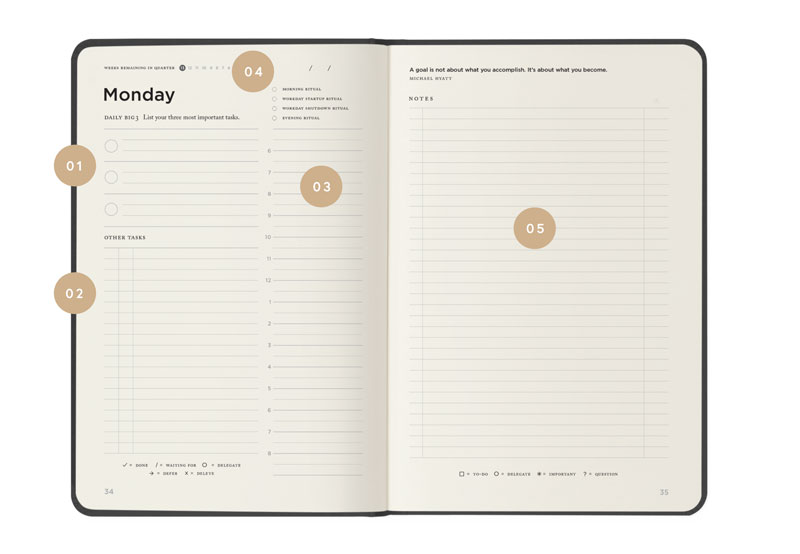Last year, my business revenue grew 62 percent. That’s the good news. The bad news is that it presents a whole new set of problems—problems I didn’t face last year.
This is where many entrepreneurs and business leaders get stuck. Let me explain.
The key to rapid growth is innovation. You develop a new product offering, marketing strategy, or operational break-through. As a result, your business scales rapidly. This happened to us. We introduced a new business coaching program and dialed in the marketing strategy for our planner business.
These innovations didn’t just happen. They resulted from making time for deliberate thinking, not just by me but by my teammates as well.
But this is where it’s easy to get derailed. When you grow rapidly, you outstrip your resources—especially time. If you’re not careful, you slip into reactive mode. When that happens, the time you previously dedicated to thinking evaporates.
If you are going to scale in a way that is sustainable, quarter after quarter, year over year, you have to stay mentally FFIT. That stands for frequent, focused, intentional, thinking.
Let’s unpack that.
Frequent. The faster you’re growing, the more time you must dedicate to thinking. This is easier if you make it a regular habit or bake it into some ritual you have already established.
Focused. Solving complex problems is—to borrow a phrase from Cal Newport—deep work. This requires single-minded focus, which you achieve by dedicating an entire “session” to solving a single problem.
Intentional. A certain amount of thinking happens unintentionally—while at the gym, on a commute, or even in the shower. But the thinking that solves thorny problems or creates ground-breaking solutions doesn’t happen by accident. It has to be done deliberately.
Thinking. One problem (among many) with the “hustle fallacy” is that it lures you into believing that doing is the key to progress. Certainly, doing is important. But the more your business grows or the more you advance in your career, the more important thinking becomes to your success. Solutions well-conceived are half achieved.
So, how do you stay FFIT?
My FFIT-ness Routine
I used to think I could do this by scheduling “think time.” For the past year, I had my assistant schedule a two-hour block on Friday afternoon for me to engage in thought work. I have a few friends who swear by this methodology. And it reportedly works well for top execs like AOL’s Tim Armstrong and Jeff Weiner of LinkedIn. But it didn’t work so well for me.
The reason is that it was too easy to cancel or push the appointment to the next week. It was a classic case of the tyranny of the urgent, where urgent tasks take precedence over important ones.
Recently I incorporated my think time into my morning ritual. That ensures that my thought work is frequent. I do this in two parts.
First, I focus on outside input. This is the focused part. This starts my thinking in a particular direction.
You can’t draw water out of an empty well. This is the value of reading, listening to podcasts, and attending conferences. You need a source of outside information to stimulate your thinking.
I do this at the gym. While I’m physically working out, I’m also mentally working out. I listen to audiobooks and podcasts. Often, I stop the recording to just ponder what I’ve heard. And sometimes it triggers a new framework or an insight into a problem I am trying to solve. Regardless, this gives me a solid 30 to 50 minutes of exposure to new ideas.
Second, I write for one hour. This is the intentional aspect of my thought work.
I do this five days a week, Monday through Friday. Nothing focuses my thinking like writing. As the saying goes, “Thoughts disentangle themselves passing over the lips and through pencil tips.”
There are a couple of advantages of doing this after my workout. For starters, I’ve just stimulated by brain by exposing it to new ideas. I typically leave the gym with two to three new ideas. In addition, because I’ve increased the blood flow to my brain, I’ve put myself in the best possible condition for creative thinking. Researchers have found that exercise facilitates information processing and memory functions, releases hormones help brain cells grow, helps make new neuronal connections.
This practice gives me a chance to solve my biggest problems and come up with my next innovations. And as a content creator, it gives me the opportunity to develop additional ideas and products.
This may seem like a lot of time to dedicate to thinking—and it is. But I’m not alone in this. Warren Buffet said, “I insist on a lot of time being spent, almost every day, to just sit and think.” He added, “I do it because I like this kind of life.” I do too, because I know it’s essential for me if I am going to keep growing. Also, since adding this practice to my morning ritual, it seems effortless. This is the value of habits and rituals.
What would it make possible for your business if you practiced frequent, focused, intentional thought? Maybe you could try my routine, or something similar? Why not experiment with it for a week or two? If it doesn’t work, you can try something else. Either way, you’ll be one step closer to staying mentally FFIT.
Disclosure of Material Connection: Some of the links in the post above are “affiliate links.” This means if you click on the link and purchase the item, we will receive an affiliate commission. Regardless, we only recommend products or services we use and believe will add value to our readers. We are disclosing this in accordance with the Federal Trade Commission’s 16 CFR, Part 255: “Guides Concerning the Use of Endorsements and Testimonials in Advertising.










